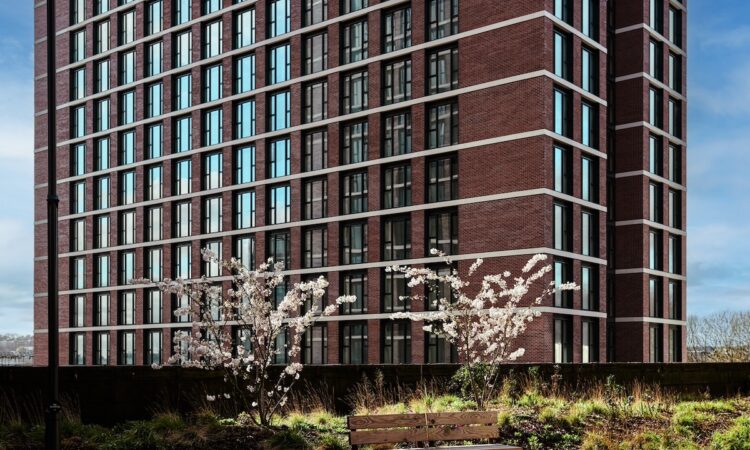


Having begun his career in the US and experienced the growth of the US Build to Rent sector first-hand, Dustin Fjeld, CEO of Fjeld Consulting offers his perspective on the UK market, drawing on valuable lessons learned from the US.
Build to Rent is showing significant growth, but what’s driving this?
The success of the Build to Rent model in the US has demonstrated its potential to transform rental markets. In the US, more than half of rental housing is owned by institutional capital, compared to just 1% to 2% in the UK.
This gap highlights the significant room for growth, accentuated with the culture and economic opportunities created by new home delivery. New homes bring new construction jobs, new local service jobs, and investment into communities.
Investors are increasingly recognising the potential scope and opportunity for Build to Rent to address chronic housing shortages in the UK, especially in urban areas where demand is high for professionally managed rental options with amenities. The model’s proven viability in the US makes it a very attractive opportunity in the UK.
Does Build to Rent help solve the UK’s housing crisis?
It’s very basic supply economics. Building enough new homes will drive down housing costs. Build to Rent offers a viable solution to housing shortages in the UK, particularly in urban areas. Its focus on large quantities of purpose-built rental homes could meet the rising demand for high-quality, affordable housing.
Government support in reforming housing policies is crucial, but the involvement of institutional capital, which can deliver large-scale projects, will be key to fully addressing the imbalance and ultimately solving the supply problem.
Why are more people choosing to rent instead of buy, and how does Build to Rent fit into this?
Rising house prices have pushed many families away from homeownership. However, some prefer the flexibility of renting, whether due to project-based jobs, divorce, or negative experiences like dealing with cladding issues, high maintenance costs, or interest-only loans.
Others might have been caught in a buyer chain, ended up with terrible neighbours, or simply want the perks of urban living – like access to cultural hubs, a golf simulator, or even concierge services for parcels.
Build to Rent provides a modern rental option with enhanced amenities and management. It is also worth noting that whilst rising rents are a concern, they are generally capped by wage growth.
Investors see Build to Rent as a long-term, stable investment opportunity, and residents benefit from the quality of life improvements that come with purpose-built housing.
What makes Build to Rent stand out from traditional rental markets?
Build to Rent offers large purpose-built homes in a smaller footprint, managed professionally with amenities similar to high-end hotels, such as gyms, communal spaces and on-site services.
The experience is tailored, offering both flexibility and a higher living standard compared to traditional buy-to-let properties. This shift mirrors global trends seen in purpose-built student accommodation and corporate co-working spaces.
How do operational efficiencies differ between US and UK Build to Rent developments?
In the UK, stricter statutory requirements ensure buildings remain compliant and safe, while in the US, compliance is more driven by the threat and risk of lawsuits. However, in the US, property management and leasing practices are more standardised and regularly audited for improvement.
By contrast, in the UK, management processes for buildings vary greatly between properties – even within the same company, making data inconsistent and difficult to compare. As the UK Build to Rent market matures, I expect this to improve.
How do operational costs impact long-term profitability in Build to Rent, and how can they be controlled?
Operational costs are critical to Build to Rent profitability, especially in the face of statutory changes, like the Fire Safety Act, which can add complexity and expense. Managing older buildings can be challenging, and sometimes, demolition and redevelopment may be more cost-effective.
Not all costs need to be included in rent – items like furniture, utilities, and cleaning services can be passed to residents. Billing residents directly for utilities, for example, can reduce consumption by up to 40%, significantly cutting costs.
What challenges arise in managing large-scale Build to Rent properties, and how are they mitigated?
One of the biggest challenges is staffing. As the Build to Rent sector is still relatively new, finding experienced, fully trained personnel can be difficult. To overcome this, hiring from related sectors like purpose-built student accommodation (PBSA) can be a smart strategy.
The turnover in PBSA is seasonal, so tapping into their talent pool, particularly after the busy summer period, can provide skilled workers who are already familiar with similar operational demands, helping to bridge the talent gap in Build to Rent.
What are the major challenges Build to Rent faces in reaching its full potential?
One of the biggest challenges is public awareness. Renters prioritise location, price and reviews – and while Build to Rent properties are often priced higher due to their newness, they should excel in reviews. Build to Rent operators need to leverage this by adopting 48-hour service guarantees, which can significantly outshine traditional independent landlords.
By delivering exceptional service, marketing positive reviews, and tracking Net Promoter Scores (NPS), Build to Rent can position itself as the superior rental option and attract more long-term residents.
What does the future hold for the UK’s Build to Rent market?
The Build to Rent market has significant room for growth, with many new developments in the pipeline. As interest rates stabilise, investment is likely to increase, allowing Build to Rent to meet the increasing demand for high-quality rental housing.
With institutional capital now more involved, and government reforms in housing policy, the sector is well-positioned to become a major force in the UK rental market over the coming decade.
